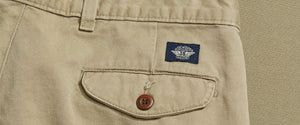Comfort, Style & Community
THE HISTORY OF KHAKI
Industrial workers. Students on ivy-covered campuses. Chicano lowrider culture. You. For almost 200 years, khakis have been the pants of choice for people the world over, remaining universally relevant because practicality and utility never get old.

While this icon was first invented by soldiers, it’s been adopted — and adapted — by pretty much everyone, regardless of decade, job or subculture. And because of this, khakis have come to define American style.
First, A Uniform.
Khaki was originally worn in the mid-nineteenth century by a regiment of the British Indian Army. At the time, their uniform consisted of white trousers and a bright red, wool coat: way too hot and way too itchy for those 100-degree-plus Indian summers. Looking to give some relief to his troops, officer Sir Harry Burnett Lumsden told them to swap the red coats with their white cotton pajamas and dye them with mud and marazi — a plant native to Punjab — to camouflage. The resulting fabric was beige, lightweight and much airier. This is just one theory of how an entire new genre of more comfortable, casual pants, was invented. Today, we call them khakis.
Inventors and Innovators - By World War I, khaki was incorporated into the official US Army uniform. Around the same time, it also became the go-to attire of explorers, adventurers and larger-than-life personalities like Teddy Roosevelt and Earnest Hemingway. Our parent company Levi Strauss & Co. responded to khaki’s popularity early on, introducing khaki pants in 1905 as an office-ready solution to blue jeans along with khaki riding suits, coats, dusters, women’s ‘hiking togs’ and more.
Wearing the Pants - Throughout World War II, women entered workforces all over the U.S. to fill the labor void left by men deployed overseas. That was many women’s first exposure to khaki, and its popularity only increased as a crop of A-list actresses started wearing khaki pants in an act of rebellion against Hollywood’s gender norms.

Post-war, returning soldiers started to evolve the way they dressed, repurposing their military-issued khakis for everyday wear. By the 1950s, they’d taken off as the go-to weekend trouser for men, while college students adopted the look as an unofficial uniform for campus life. Levi’s® was right on it, introducing Tab Twills that bear a striking resemblance to the Dockers® you know and love.
Dockers® Disrupts
So how did Dockers® become synonymous with khaki? In 1985, Levi Strauss & Co. employee Susan Kilgore brought a pair of khaki pants made by Levi’s® Japan to the U.S. for a big meeting. They had named them ‘Dockers’: a colloquial word used to describe longshoremen in Britain. They turned out to be a big hit. In those pants, Levi’s® saw an opportunity: to give baby boomers — who had grown up in Levi’s® jeans and were now certified professionals — something to wear that straddled the line between office-appropriate suits and the denim they loved so much. So they started ramping up their khaki manufacturing. One year later, they created an entire brand devoted to it — and so, the Dockers® you know today was born.
Dockers® challenged formality in the workplace by introducing the concept of Casual Fridays to corporate America. We did that by mailing a glossy 'Guide To Casual Business Wear” to thousands of HR managers across the country. The guide taught them a whole new way to view office attire through a casual, Californian lens — with an emphasis on khakis, polos and button-ups. Dockers® became the unofficial uniform in cutting-edge and creative industries where people prioritized bringing their authentic selves to work.

While people often think of khakis in a ’90s context, it’s been reinvented time and time again in the modern era, especially through diverse subcultural movements. From Chicano street culture’s love of belted, oversized khakis and its influence on Venice skate scenes to hip hop legends, one thing is very clear: khaki is endlessly versatile — and it’s here to stay. So how will you wear them?










